Summary: Transformative learning is a theory of adult learning that utilizes disorienting dilemmas to challenge students’ thinking. Students are then encouraged to use critical thinking and questioning to consider if their underlying assumptions and beliefs about the world are accurate.
Originator: Jack Mezirow (1923-2014)
Keywords: adult education, higher education, academic development, disorienting dilemmas, assumptions, beliefs, worldview, change, transformation, critical reflection
Transformative learning theory was developed by Jack Mezirow in the late 1900s. He used this theory to describe how people develop and use critical self-reflecting to consider their beliefs and experiences, and over time, change dysfunctional means of seeing the world. Mezirow was interested in peoples’ worldviews and what leads people to change their particular view of the world.[i]
Mezirow describes transformative learning as “learning that transforms problematic frames of reference to make them more inclusive, discriminating, reflective, open, and emotionally able to change.”[ii]
So, what must happen for a person to change their view of the world? Mezirow believed that this occurs when people face a “disorienting dilemma.” Disorienting dilemmas are experiences that don’t fit into a person’s current beliefs about the world. When faced with a disorienting dilemma, people are forced to reconsider their beliefs in a way that will fit this new experience into the rest of their worldview. This often happens through “critical reflection” in the context of dialogue with other people.[iii]
A Case Study
Researcher Michael Christie presents the following case study as a real life example of transformative learning theory in action. Christie describes his experience teaching adult woman in a Graduate Diploma course for Adult and Vocational Educators. Throughout the course, he asked his students to “keep a critical incident file of their experiences.”
The content of the course provided many new ideas that functioned as disorienting dilemmas for these woman. The woman were forced to think through their assumptions in a number of areas, including beliefs about gender roles. Christie states, “For example, the belief that ‘a woman’s place is in the home’ was undermined, the assumptions underpinning it challenged, and a new perspective enacted.”
Applications of Transformative Learning Theory
Disorienting dilemmas often occur in the context of academic learning environments, as teachers provide space to critically engage with new ideas. Teachers who want to utilize transformative learning in their classrooms can consider implementing the following opportunities for students.
- Providing opportunities for critical thinking – Teachers can create opportunities for critical thinking through providing content that introduces new ideas. Students then need the opportunity to engage with new content through journaling, dialoguing with other students, and critically questioning their own assumptions and beliefs.
- Providing opportunities to relate to others going through the same transformative process – Transformation often happens in community as students bounce ideas off one another and are inspired by the changes friends and acquaintances make.
- Providing opportunities to act on new perspectives – Finally, research indicates that it is critical for teachers to provide the opportunity for students to act on their new found beliefs. There is some indication that true transformation cannot take place until students are able to actively take steps that acknowledge their new belief.
References
[i] Christie, M., Carey, M., Robertson, A., & Grainger, P. (2015). Putting transformative learning theory into practice. Australian Journal of Adult Learning, 55(1), 10-30
[ii] Mezirow, J. (2009). Transformative learning theory. In J. Mezirow, and E. W. Taylor (Eds), Transformative Learning in Practise: Insights from Community.
[iii] Howie, P. & Bagnall, R. (2013). A beautiful metaphor: Transformative learning theory. International Journal of Lifelong Education, 32(6), 816-836.



